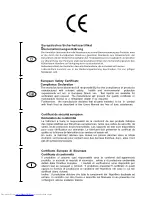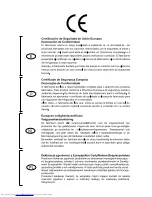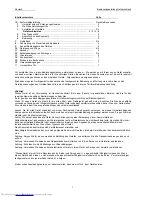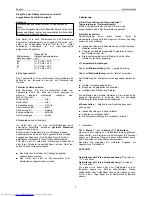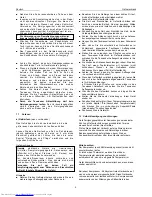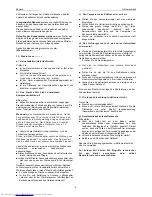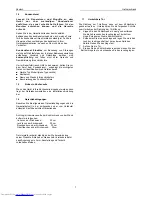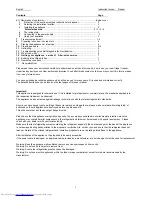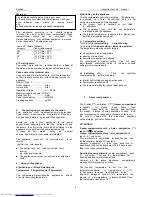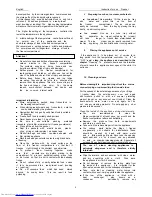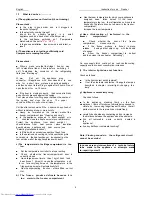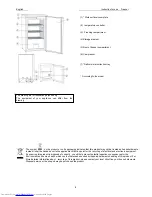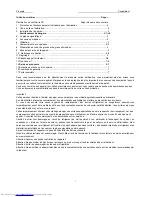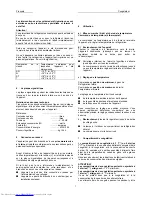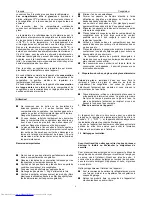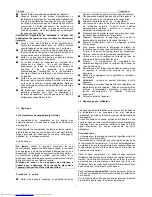
English
Instruction for use Freezer
2
The user instructions apply to several models, for
this reason there may be some differences in
the details given, according to the type of the appliance..
1 Protecting the environment / advice for disposal
Packing
serves to protect the appliance during transportation and
recyclable materials have been used for packaging.
Corrugated board/cardboard (mainly from waste paper).
- shaped parts in PS (foamed CFC- free polystyrene)
- foils and bags in PE (polyethylene)
- strapping tapes in PP (polypropylene)
- Please hand over all packaging to the nearest official
collection point, so that all the different materials can
be re-used or recycled as far as possible and
any illegal depositing of such materials is thus avoided
2 Deciding where to locate your appliance
In order to avoid any damage or injury to
persons or things, the appliance should be unpacked
by two people and placed in the chosen location
Before positioning it, check
that your new appliance
has no visible outer damage.
On no account
should you start up your appliance if it is
damaged. Check the appliance carefully for:
■
Damage to the packaging
which might indicate that
appliance has been mishandled during transportation
■
Damage to the outer casing
■
Any visible damage to the cable / plug
If in any doubt
let the customer service
department
check the appliance.
It must at all costs be avoided,
that any environmentally
damaging refrigerant leaks out by starting up the
appliance.
3 Installing your appliance
a) Unpack the fridge / freezer.
b) Remove any objects from inside the appliance
c) Carefully remove all film and adhesive tape from the
casing from the door
d) Remove any polystyrene pieces from
around the compressor (if present).
e) Remove all documents and accessories from
inside the appliance.
f) Clean the inside of the appliance with
lukewarm water and vinegar and dry it
thoroughly with a soft cloth.
Do not use washing liquids, sharp or
abrasive household products or any other
cleaning agents containing soda.
■
Make sure that the pipes for the circulation of the
refrigerant are not damaged in any way during
installation of the appliance.
■
The appliance must only be used for the purpose
for which it is intended.
■
The appliance. must be placed on a firm,
level surface. This is the only way to ensure
that the refrigerant can circulate freely and thus
ensure that your appliance will work effciently.
■
If possible, place your appliance in a cool,
well aired, dry room.
■
Do not place your appliance in direct sunlight, nor in a
room at high temperature.
■
Do not place your appliance in the vicinity
of any sources of direct heat such as heating, ovens,
cooking stove etc. (This would mean the
compressor would have to work harder and as
a result the power consumption would be
considerably higher).
If installation near a direct heat source
cannot be avoided, we recommend fitting a
suitable insulation plate between the appliance and
the heat source (do not use asbestos), or at least
the following minimum distances must be observed: .
■
from a gas or electric cooker
30cm
■
from a radiator or oven etc
30 cm
■
from another refrigerating appliance
30 cm
Do not place any appliances, such as microwaves,
toasters etc. which give off heat on the
appliance
Never obstruct the ventilation grille.
Always pull out the plug itself and never pull the
cable when cutting the appliance off from the mains
supply.
WARNING !
Leave the appliance standing in its final position for
at least 2 hours before switching it on, so that the
circulation of the refrigerant stabilises and
no operating problems occur.
Before connecting up the appliance, make sure that it
is absolutely dry inside - especially in the corners..
Danger warnings
Depending on its composition, the refrigerant can
be easily inflammable. The refrigerant circuit
has been hermetically sealed and has been tested
many times for possible leaks. Any inexpert interference
might well create a fire hazard. Make sure nothing
mechanically effects the circulation of the refrigerant,
nor, in particular, the accessible parts around the
compressor..
Only expert professional personnel should intervene
on the refrigerating system.


